Assessment of Patient Information at UTS Hospital
VerifiedAdded on 2023/06/03
|14
|3632
|278
AI Summary
This report assesses patient data from UTS Hospital, covering issues such as ICU hours, financial status, and level of emergency. Findings show that General Medicine received the most patients, with the majority between 21-40 years old and married. Acute service category received almost all patients, and the main mode of separation was discharge by the hospital.
Contribute Materials
Your contribution can guide someone’s learning journey. Share your
documents today.
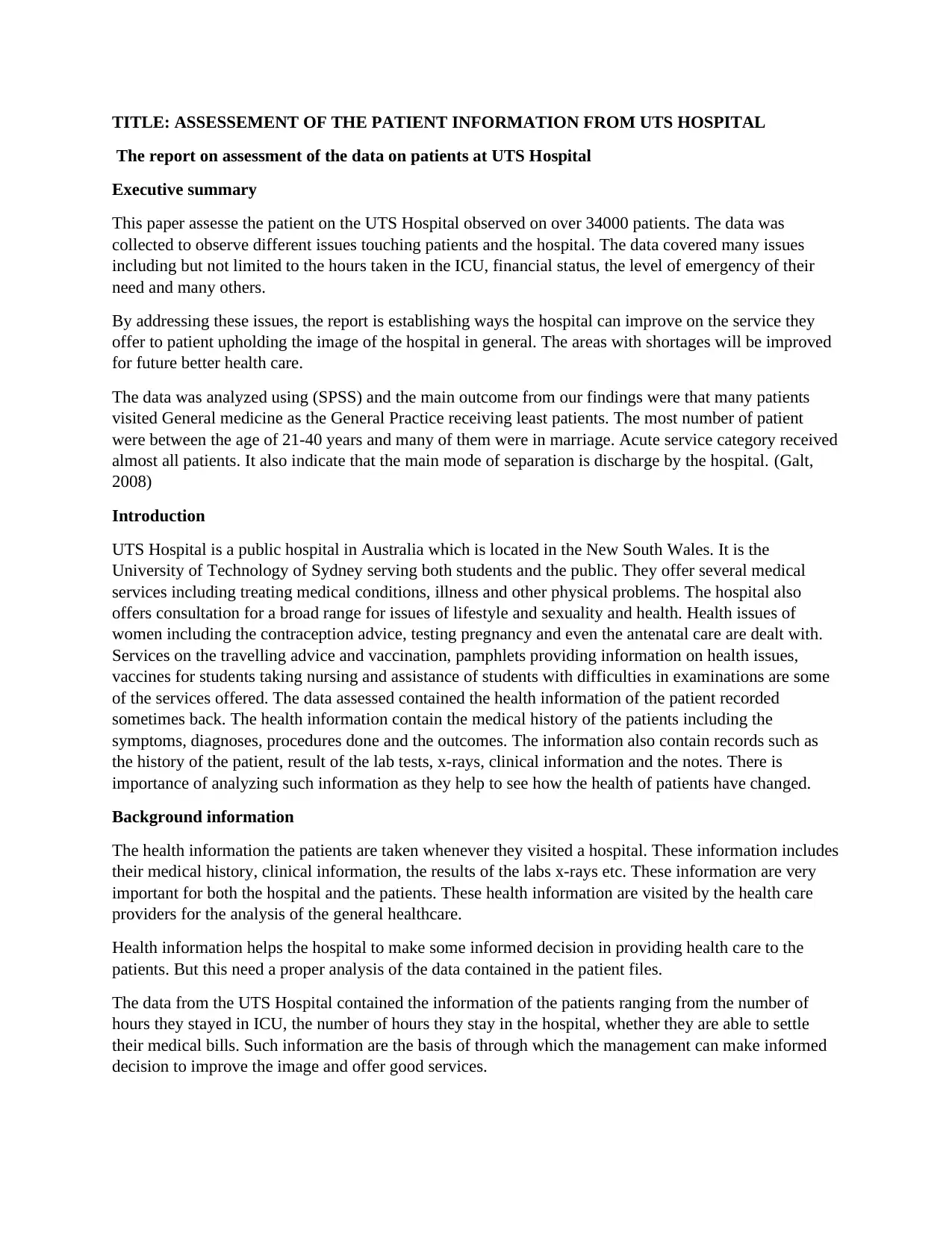
TITLE: ASSESSEMENT OF THE PATIENT INFORMATION FROM UTS HOSPITAL
The report on assessment of the data on patients at UTS Hospital
Executive summary
This paper assesse the patient on the UTS Hospital observed on over 34000 patients. The data was
collected to observe different issues touching patients and the hospital. The data covered many issues
including but not limited to the hours taken in the ICU, financial status, the level of emergency of their
need and many others.
By addressing these issues, the report is establishing ways the hospital can improve on the service they
offer to patient upholding the image of the hospital in general. The areas with shortages will be improved
for future better health care.
The data was analyzed using (SPSS) and the main outcome from our findings were that many patients
visited General medicine as the General Practice receiving least patients. The most number of patient
were between the age of 21-40 years and many of them were in marriage. Acute service category received
almost all patients. It also indicate that the main mode of separation is discharge by the hospital. (Galt,
2008)
Introduction
UTS Hospital is a public hospital in Australia which is located in the New South Wales. It is the
University of Technology of Sydney serving both students and the public. They offer several medical
services including treating medical conditions, illness and other physical problems. The hospital also
offers consultation for a broad range for issues of lifestyle and sexuality and health. Health issues of
women including the contraception advice, testing pregnancy and even the antenatal care are dealt with.
Services on the travelling advice and vaccination, pamphlets providing information on health issues,
vaccines for students taking nursing and assistance of students with difficulties in examinations are some
of the services offered. The data assessed contained the health information of the patient recorded
sometimes back. The health information contain the medical history of the patients including the
symptoms, diagnoses, procedures done and the outcomes. The information also contain records such as
the history of the patient, result of the lab tests, x-rays, clinical information and the notes. There is
importance of analyzing such information as they help to see how the health of patients have changed.
Background information
The health information the patients are taken whenever they visited a hospital. These information includes
their medical history, clinical information, the results of the labs x-rays etc. These information are very
important for both the hospital and the patients. These health information are visited by the health care
providers for the analysis of the general healthcare.
Health information helps the hospital to make some informed decision in providing health care to the
patients. But this need a proper analysis of the data contained in the patient files.
The data from the UTS Hospital contained the information of the patients ranging from the number of
hours they stayed in ICU, the number of hours they stay in the hospital, whether they are able to settle
their medical bills. Such information are the basis of through which the management can make informed
decision to improve the image and offer good services.
The report on assessment of the data on patients at UTS Hospital
Executive summary
This paper assesse the patient on the UTS Hospital observed on over 34000 patients. The data was
collected to observe different issues touching patients and the hospital. The data covered many issues
including but not limited to the hours taken in the ICU, financial status, the level of emergency of their
need and many others.
By addressing these issues, the report is establishing ways the hospital can improve on the service they
offer to patient upholding the image of the hospital in general. The areas with shortages will be improved
for future better health care.
The data was analyzed using (SPSS) and the main outcome from our findings were that many patients
visited General medicine as the General Practice receiving least patients. The most number of patient
were between the age of 21-40 years and many of them were in marriage. Acute service category received
almost all patients. It also indicate that the main mode of separation is discharge by the hospital. (Galt,
2008)
Introduction
UTS Hospital is a public hospital in Australia which is located in the New South Wales. It is the
University of Technology of Sydney serving both students and the public. They offer several medical
services including treating medical conditions, illness and other physical problems. The hospital also
offers consultation for a broad range for issues of lifestyle and sexuality and health. Health issues of
women including the contraception advice, testing pregnancy and even the antenatal care are dealt with.
Services on the travelling advice and vaccination, pamphlets providing information on health issues,
vaccines for students taking nursing and assistance of students with difficulties in examinations are some
of the services offered. The data assessed contained the health information of the patient recorded
sometimes back. The health information contain the medical history of the patients including the
symptoms, diagnoses, procedures done and the outcomes. The information also contain records such as
the history of the patient, result of the lab tests, x-rays, clinical information and the notes. There is
importance of analyzing such information as they help to see how the health of patients have changed.
Background information
The health information the patients are taken whenever they visited a hospital. These information includes
their medical history, clinical information, the results of the labs x-rays etc. These information are very
important for both the hospital and the patients. These health information are visited by the health care
providers for the analysis of the general healthcare.
Health information helps the hospital to make some informed decision in providing health care to the
patients. But this need a proper analysis of the data contained in the patient files.
The data from the UTS Hospital contained the information of the patients ranging from the number of
hours they stayed in ICU, the number of hours they stay in the hospital, whether they are able to settle
their medical bills. Such information are the basis of through which the management can make informed
decision to improve the image and offer good services.
Secure Best Marks with AI Grader
Need help grading? Try our AI Grader for instant feedback on your assignments.
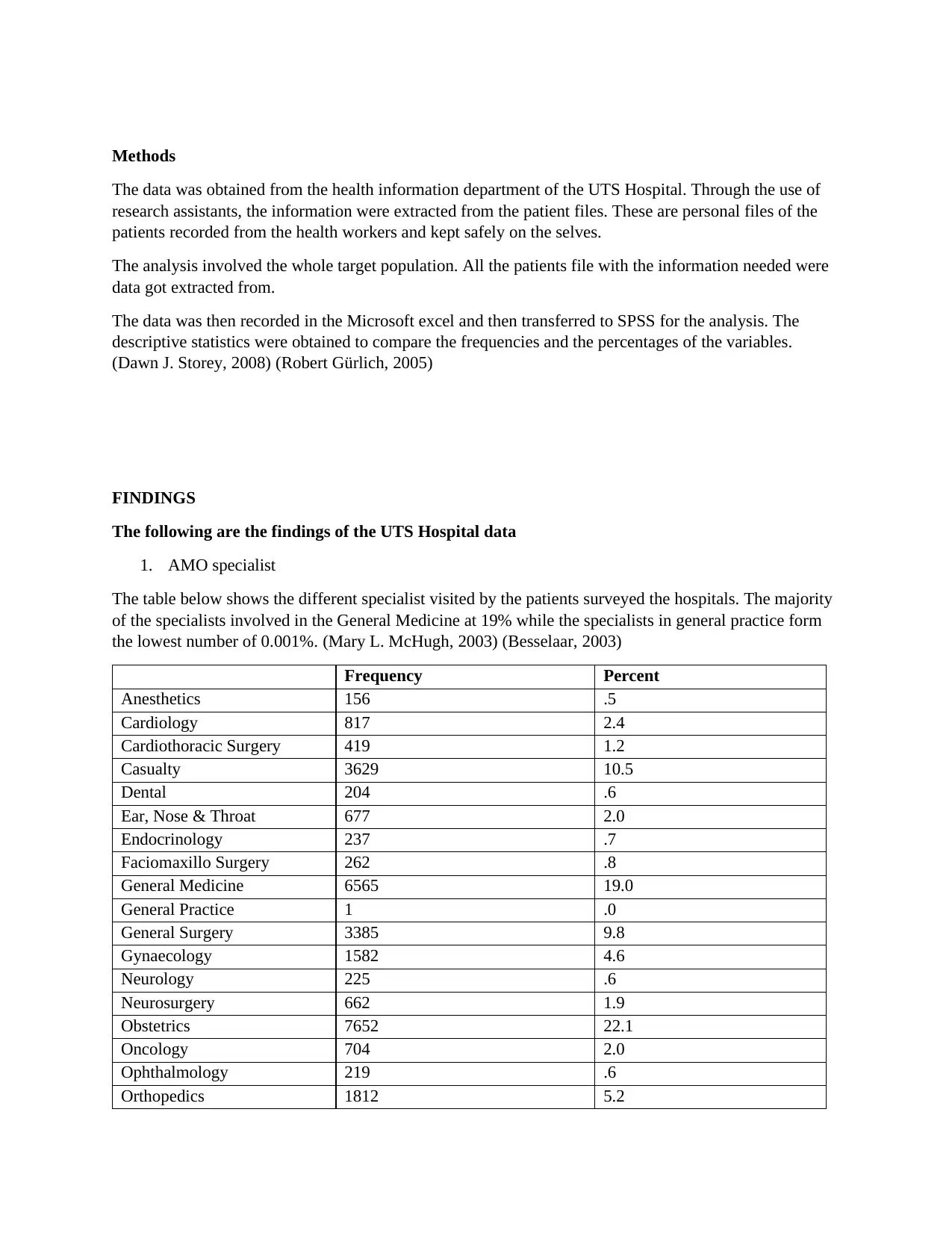
Methods
The data was obtained from the health information department of the UTS Hospital. Through the use of
research assistants, the information were extracted from the patient files. These are personal files of the
patients recorded from the health workers and kept safely on the selves.
The analysis involved the whole target population. All the patients file with the information needed were
data got extracted from.
The data was then recorded in the Microsoft excel and then transferred to SPSS for the analysis. The
descriptive statistics were obtained to compare the frequencies and the percentages of the variables.
(Dawn J. Storey, 2008) (Robert Gürlich, 2005)
FINDINGS
The following are the findings of the UTS Hospital data
1. AMO specialist
The table below shows the different specialist visited by the patients surveyed the hospitals. The majority
of the specialists involved in the General Medicine at 19% while the specialists in general practice form
the lowest number of 0.001%. (Mary L. McHugh, 2003) (Besselaar, 2003)
Frequency Percent
Anesthetics 156 .5
Cardiology 817 2.4
Cardiothoracic Surgery 419 1.2
Casualty 3629 10.5
Dental 204 .6
Ear, Nose & Throat 677 2.0
Endocrinology 237 .7
Faciomaxillo Surgery 262 .8
General Medicine 6565 19.0
General Practice 1 .0
General Surgery 3385 9.8
Gynaecology 1582 4.6
Neurology 225 .6
Neurosurgery 662 1.9
Obstetrics 7652 22.1
Oncology 704 2.0
Ophthalmology 219 .6
Orthopedics 1812 5.2
The data was obtained from the health information department of the UTS Hospital. Through the use of
research assistants, the information were extracted from the patient files. These are personal files of the
patients recorded from the health workers and kept safely on the selves.
The analysis involved the whole target population. All the patients file with the information needed were
data got extracted from.
The data was then recorded in the Microsoft excel and then transferred to SPSS for the analysis. The
descriptive statistics were obtained to compare the frequencies and the percentages of the variables.
(Dawn J. Storey, 2008) (Robert Gürlich, 2005)
FINDINGS
The following are the findings of the UTS Hospital data
1. AMO specialist
The table below shows the different specialist visited by the patients surveyed the hospitals. The majority
of the specialists involved in the General Medicine at 19% while the specialists in general practice form
the lowest number of 0.001%. (Mary L. McHugh, 2003) (Besselaar, 2003)
Frequency Percent
Anesthetics 156 .5
Cardiology 817 2.4
Cardiothoracic Surgery 419 1.2
Casualty 3629 10.5
Dental 204 .6
Ear, Nose & Throat 677 2.0
Endocrinology 237 .7
Faciomaxillo Surgery 262 .8
General Medicine 6565 19.0
General Practice 1 .0
General Surgery 3385 9.8
Gynaecology 1582 4.6
Neurology 225 .6
Neurosurgery 662 1.9
Obstetrics 7652 22.1
Oncology 704 2.0
Ophthalmology 219 .6
Orthopedics 1812 5.2
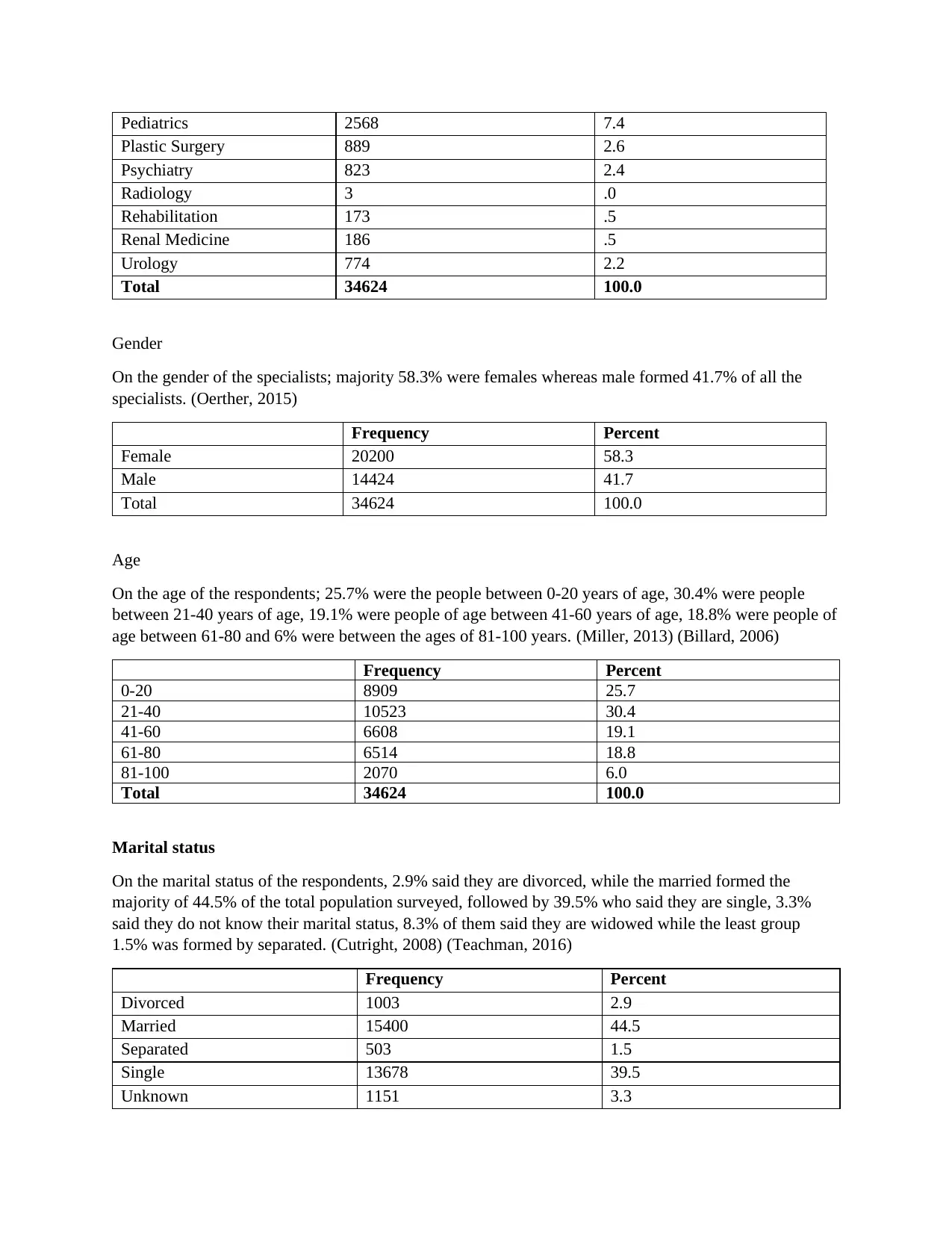
Pediatrics 2568 7.4
Plastic Surgery 889 2.6
Psychiatry 823 2.4
Radiology 3 .0
Rehabilitation 173 .5
Renal Medicine 186 .5
Urology 774 2.2
Total 34624 100.0
Gender
On the gender of the specialists; majority 58.3% were females whereas male formed 41.7% of all the
specialists. (Oerther, 2015)
Frequency Percent
Female 20200 58.3
Male 14424 41.7
Total 34624 100.0
Age
On the age of the respondents; 25.7% were the people between 0-20 years of age, 30.4% were people
between 21-40 years of age, 19.1% were people of age between 41-60 years of age, 18.8% were people of
age between 61-80 and 6% were between the ages of 81-100 years. (Miller, 2013) (Billard, 2006)
Frequency Percent
0-20 8909 25.7
21-40 10523 30.4
41-60 6608 19.1
61-80 6514 18.8
81-100 2070 6.0
Total 34624 100.0
Marital status
On the marital status of the respondents, 2.9% said they are divorced, while the married formed the
majority of 44.5% of the total population surveyed, followed by 39.5% who said they are single, 3.3%
said they do not know their marital status, 8.3% of them said they are widowed while the least group
1.5% was formed by separated. (Cutright, 2008) (Teachman, 2016)
Frequency Percent
Divorced 1003 2.9
Married 15400 44.5
Separated 503 1.5
Single 13678 39.5
Unknown 1151 3.3
Plastic Surgery 889 2.6
Psychiatry 823 2.4
Radiology 3 .0
Rehabilitation 173 .5
Renal Medicine 186 .5
Urology 774 2.2
Total 34624 100.0
Gender
On the gender of the specialists; majority 58.3% were females whereas male formed 41.7% of all the
specialists. (Oerther, 2015)
Frequency Percent
Female 20200 58.3
Male 14424 41.7
Total 34624 100.0
Age
On the age of the respondents; 25.7% were the people between 0-20 years of age, 30.4% were people
between 21-40 years of age, 19.1% were people of age between 41-60 years of age, 18.8% were people of
age between 61-80 and 6% were between the ages of 81-100 years. (Miller, 2013) (Billard, 2006)
Frequency Percent
0-20 8909 25.7
21-40 10523 30.4
41-60 6608 19.1
61-80 6514 18.8
81-100 2070 6.0
Total 34624 100.0
Marital status
On the marital status of the respondents, 2.9% said they are divorced, while the married formed the
majority of 44.5% of the total population surveyed, followed by 39.5% who said they are single, 3.3%
said they do not know their marital status, 8.3% of them said they are widowed while the least group
1.5% was formed by separated. (Cutright, 2008) (Teachman, 2016)
Frequency Percent
Divorced 1003 2.9
Married 15400 44.5
Separated 503 1.5
Single 13678 39.5
Unknown 1151 3.3
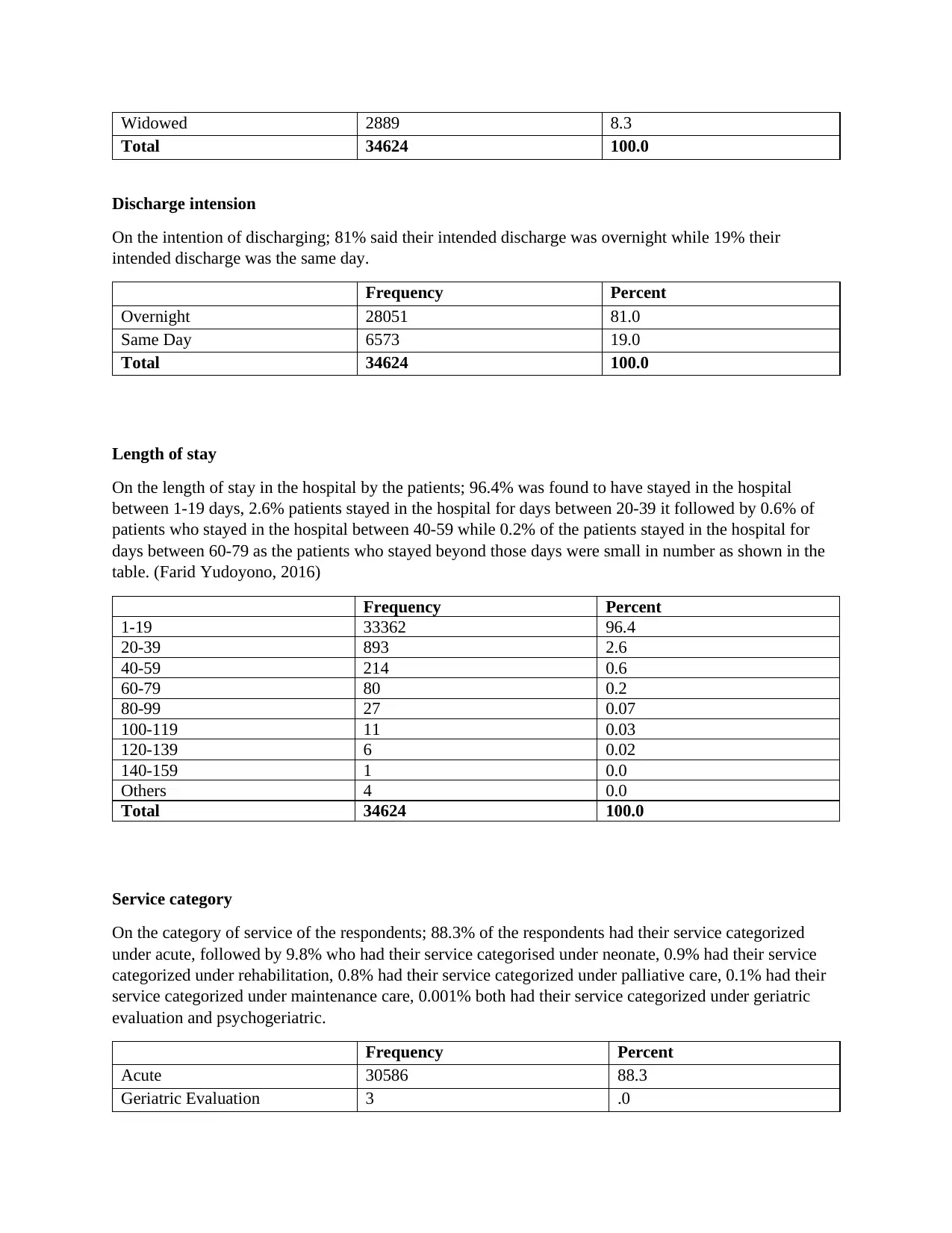
Widowed 2889 8.3
Total 34624 100.0
Discharge intension
On the intention of discharging; 81% said their intended discharge was overnight while 19% their
intended discharge was the same day.
Frequency Percent
Overnight 28051 81.0
Same Day 6573 19.0
Total 34624 100.0
Length of stay
On the length of stay in the hospital by the patients; 96.4% was found to have stayed in the hospital
between 1-19 days, 2.6% patients stayed in the hospital for days between 20-39 it followed by 0.6% of
patients who stayed in the hospital between 40-59 while 0.2% of the patients stayed in the hospital for
days between 60-79 as the patients who stayed beyond those days were small in number as shown in the
table. (Farid Yudoyono, 2016)
Frequency Percent
1-19 33362 96.4
20-39 893 2.6
40-59 214 0.6
60-79 80 0.2
80-99 27 0.07
100-119 11 0.03
120-139 6 0.02
140-159 1 0.0
Others 4 0.0
Total 34624 100.0
Service category
On the category of service of the respondents; 88.3% of the respondents had their service categorized
under acute, followed by 9.8% who had their service categorised under neonate, 0.9% had their service
categorized under rehabilitation, 0.8% had their service categorized under palliative care, 0.1% had their
service categorized under maintenance care, 0.001% both had their service categorized under geriatric
evaluation and psychogeriatric.
Frequency Percent
Acute 30586 88.3
Geriatric Evaluation 3 .0
Total 34624 100.0
Discharge intension
On the intention of discharging; 81% said their intended discharge was overnight while 19% their
intended discharge was the same day.
Frequency Percent
Overnight 28051 81.0
Same Day 6573 19.0
Total 34624 100.0
Length of stay
On the length of stay in the hospital by the patients; 96.4% was found to have stayed in the hospital
between 1-19 days, 2.6% patients stayed in the hospital for days between 20-39 it followed by 0.6% of
patients who stayed in the hospital between 40-59 while 0.2% of the patients stayed in the hospital for
days between 60-79 as the patients who stayed beyond those days were small in number as shown in the
table. (Farid Yudoyono, 2016)
Frequency Percent
1-19 33362 96.4
20-39 893 2.6
40-59 214 0.6
60-79 80 0.2
80-99 27 0.07
100-119 11 0.03
120-139 6 0.02
140-159 1 0.0
Others 4 0.0
Total 34624 100.0
Service category
On the category of service of the respondents; 88.3% of the respondents had their service categorized
under acute, followed by 9.8% who had their service categorised under neonate, 0.9% had their service
categorized under rehabilitation, 0.8% had their service categorized under palliative care, 0.1% had their
service categorized under maintenance care, 0.001% both had their service categorized under geriatric
evaluation and psychogeriatric.
Frequency Percent
Acute 30586 88.3
Geriatric Evaluation 3 .0
Secure Best Marks with AI Grader
Need help grading? Try our AI Grader for instant feedback on your assignments.
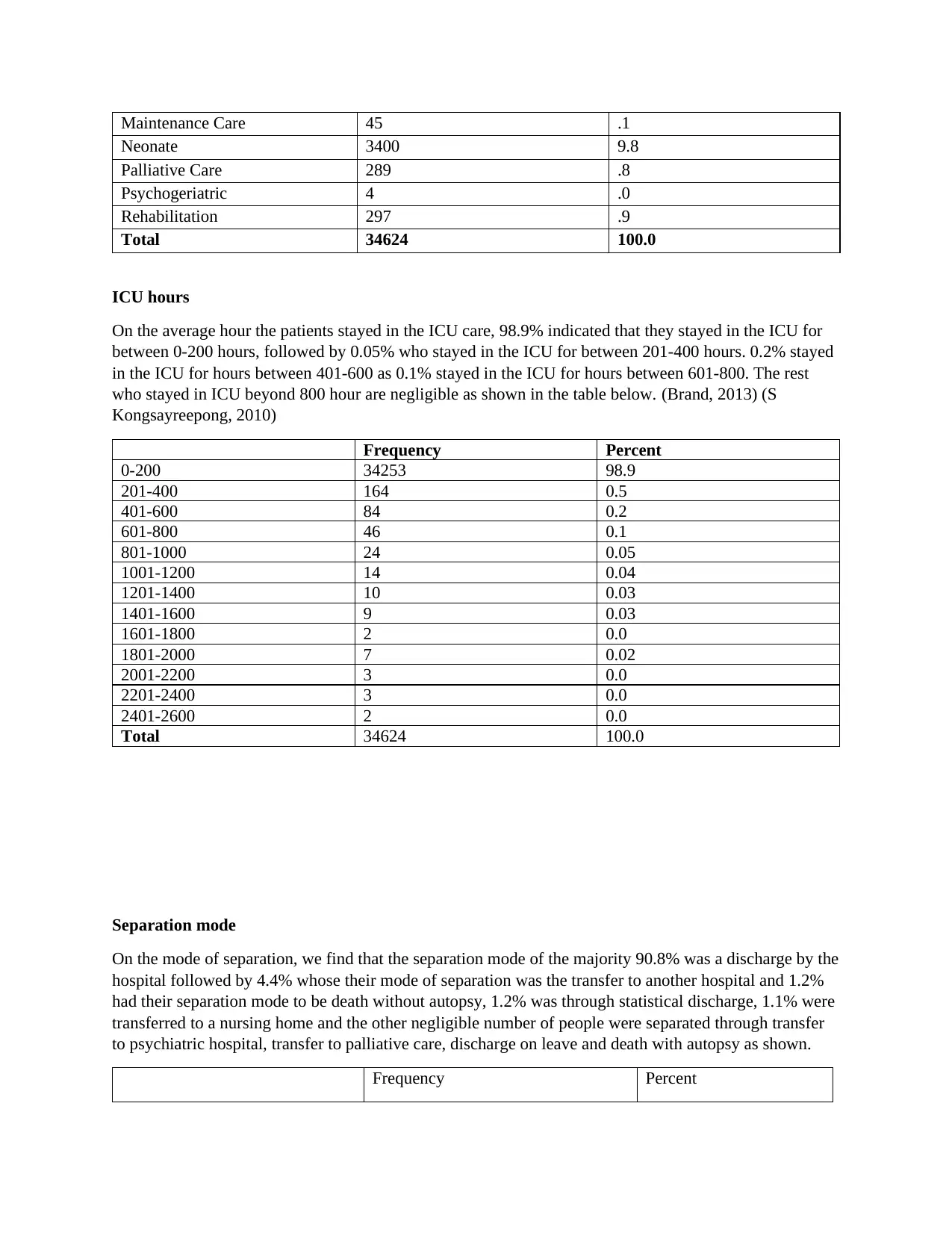
Maintenance Care 45 .1
Neonate 3400 9.8
Palliative Care 289 .8
Psychogeriatric 4 .0
Rehabilitation 297 .9
Total 34624 100.0
ICU hours
On the average hour the patients stayed in the ICU care, 98.9% indicated that they stayed in the ICU for
between 0-200 hours, followed by 0.05% who stayed in the ICU for between 201-400 hours. 0.2% stayed
in the ICU for hours between 401-600 as 0.1% stayed in the ICU for hours between 601-800. The rest
who stayed in ICU beyond 800 hour are negligible as shown in the table below. (Brand, 2013) (S
Kongsayreepong, 2010)
Frequency Percent
0-200 34253 98.9
201-400 164 0.5
401-600 84 0.2
601-800 46 0.1
801-1000 24 0.05
1001-1200 14 0.04
1201-1400 10 0.03
1401-1600 9 0.03
1601-1800 2 0.0
1801-2000 7 0.02
2001-2200 3 0.0
2201-2400 3 0.0
2401-2600 2 0.0
Total 34624 100.0
Separation mode
On the mode of separation, we find that the separation mode of the majority 90.8% was a discharge by the
hospital followed by 4.4% whose their mode of separation was the transfer to another hospital and 1.2%
had their separation mode to be death without autopsy, 1.2% was through statistical discharge, 1.1% were
transferred to a nursing home and the other negligible number of people were separated through transfer
to psychiatric hospital, transfer to palliative care, discharge on leave and death with autopsy as shown.
Frequency Percent
Neonate 3400 9.8
Palliative Care 289 .8
Psychogeriatric 4 .0
Rehabilitation 297 .9
Total 34624 100.0
ICU hours
On the average hour the patients stayed in the ICU care, 98.9% indicated that they stayed in the ICU for
between 0-200 hours, followed by 0.05% who stayed in the ICU for between 201-400 hours. 0.2% stayed
in the ICU for hours between 401-600 as 0.1% stayed in the ICU for hours between 601-800. The rest
who stayed in ICU beyond 800 hour are negligible as shown in the table below. (Brand, 2013) (S
Kongsayreepong, 2010)
Frequency Percent
0-200 34253 98.9
201-400 164 0.5
401-600 84 0.2
601-800 46 0.1
801-1000 24 0.05
1001-1200 14 0.04
1201-1400 10 0.03
1401-1600 9 0.03
1601-1800 2 0.0
1801-2000 7 0.02
2001-2200 3 0.0
2201-2400 3 0.0
2401-2600 2 0.0
Total 34624 100.0
Separation mode
On the mode of separation, we find that the separation mode of the majority 90.8% was a discharge by the
hospital followed by 4.4% whose their mode of separation was the transfer to another hospital and 1.2%
had their separation mode to be death without autopsy, 1.2% was through statistical discharge, 1.1% were
transferred to a nursing home and the other negligible number of people were separated through transfer
to psychiatric hospital, transfer to palliative care, discharge on leave and death with autopsy as shown.
Frequency Percent
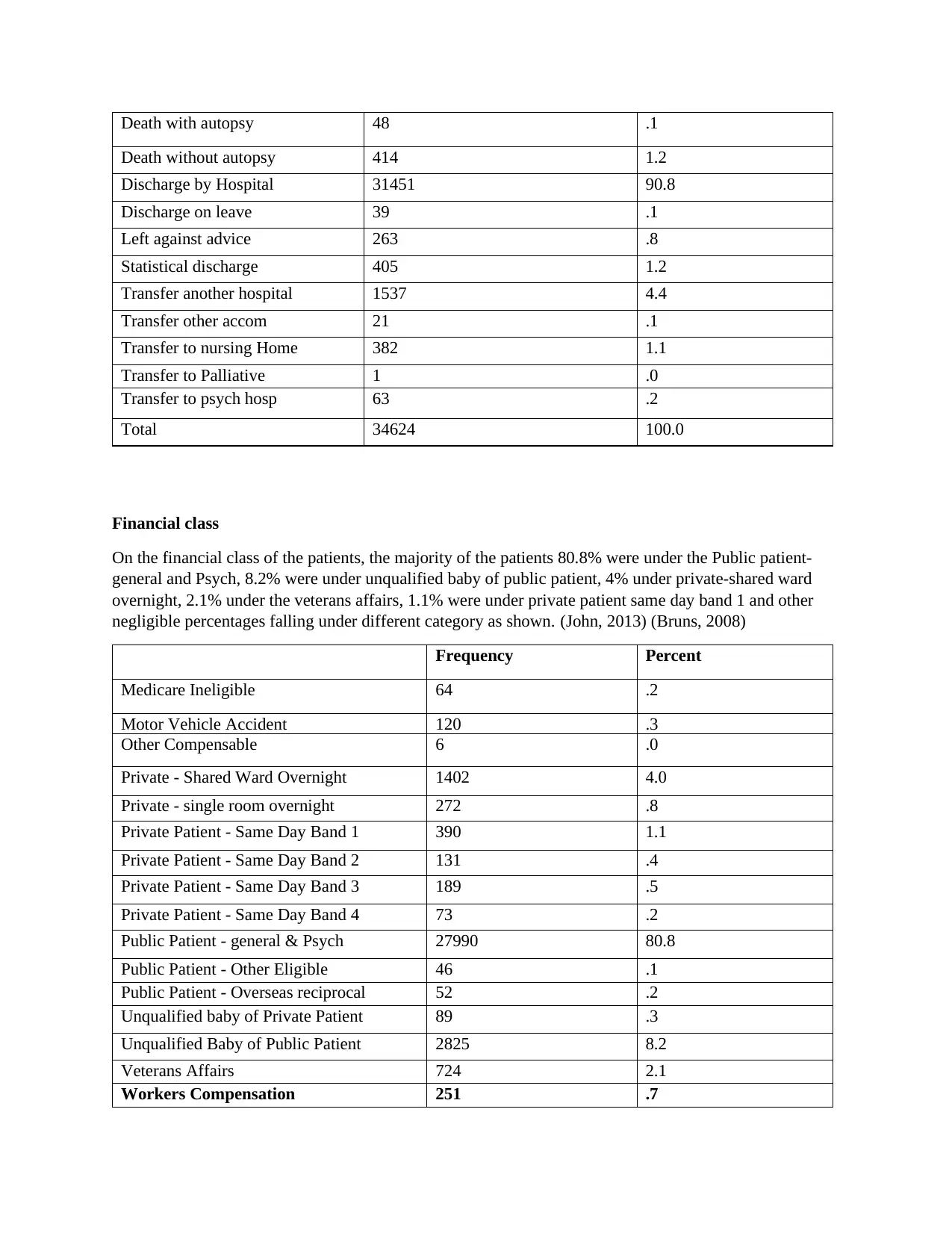
Death with autopsy 48 .1
Death without autopsy 414 1.2
Discharge by Hospital 31451 90.8
Discharge on leave 39 .1
Left against advice 263 .8
Statistical discharge 405 1.2
Transfer another hospital 1537 4.4
Transfer other accom 21 .1
Transfer to nursing Home 382 1.1
Transfer to Palliative 1 .0
Transfer to psych hosp 63 .2
Total 34624 100.0
Financial class
On the financial class of the patients, the majority of the patients 80.8% were under the Public patient-
general and Psych, 8.2% were under unqualified baby of public patient, 4% under private-shared ward
overnight, 2.1% under the veterans affairs, 1.1% were under private patient same day band 1 and other
negligible percentages falling under different category as shown. (John, 2013) (Bruns, 2008)
Frequency Percent
Medicare Ineligible 64 .2
Motor Vehicle Accident 120 .3
Other Compensable 6 .0
Private - Shared Ward Overnight 1402 4.0
Private - single room overnight 272 .8
Private Patient - Same Day Band 1 390 1.1
Private Patient - Same Day Band 2 131 .4
Private Patient - Same Day Band 3 189 .5
Private Patient - Same Day Band 4 73 .2
Public Patient - general & Psych 27990 80.8
Public Patient - Other Eligible 46 .1
Public Patient - Overseas reciprocal 52 .2
Unqualified baby of Private Patient 89 .3
Unqualified Baby of Public Patient 2825 8.2
Veterans Affairs 724 2.1
Workers Compensation 251 .7
Death without autopsy 414 1.2
Discharge by Hospital 31451 90.8
Discharge on leave 39 .1
Left against advice 263 .8
Statistical discharge 405 1.2
Transfer another hospital 1537 4.4
Transfer other accom 21 .1
Transfer to nursing Home 382 1.1
Transfer to Palliative 1 .0
Transfer to psych hosp 63 .2
Total 34624 100.0
Financial class
On the financial class of the patients, the majority of the patients 80.8% were under the Public patient-
general and Psych, 8.2% were under unqualified baby of public patient, 4% under private-shared ward
overnight, 2.1% under the veterans affairs, 1.1% were under private patient same day band 1 and other
negligible percentages falling under different category as shown. (John, 2013) (Bruns, 2008)
Frequency Percent
Medicare Ineligible 64 .2
Motor Vehicle Accident 120 .3
Other Compensable 6 .0
Private - Shared Ward Overnight 1402 4.0
Private - single room overnight 272 .8
Private Patient - Same Day Band 1 390 1.1
Private Patient - Same Day Band 2 131 .4
Private Patient - Same Day Band 3 189 .5
Private Patient - Same Day Band 4 73 .2
Public Patient - general & Psych 27990 80.8
Public Patient - Other Eligible 46 .1
Public Patient - Overseas reciprocal 52 .2
Unqualified baby of Private Patient 89 .3
Unqualified Baby of Public Patient 2825 8.2
Veterans Affairs 724 2.1
Workers Compensation 251 .7
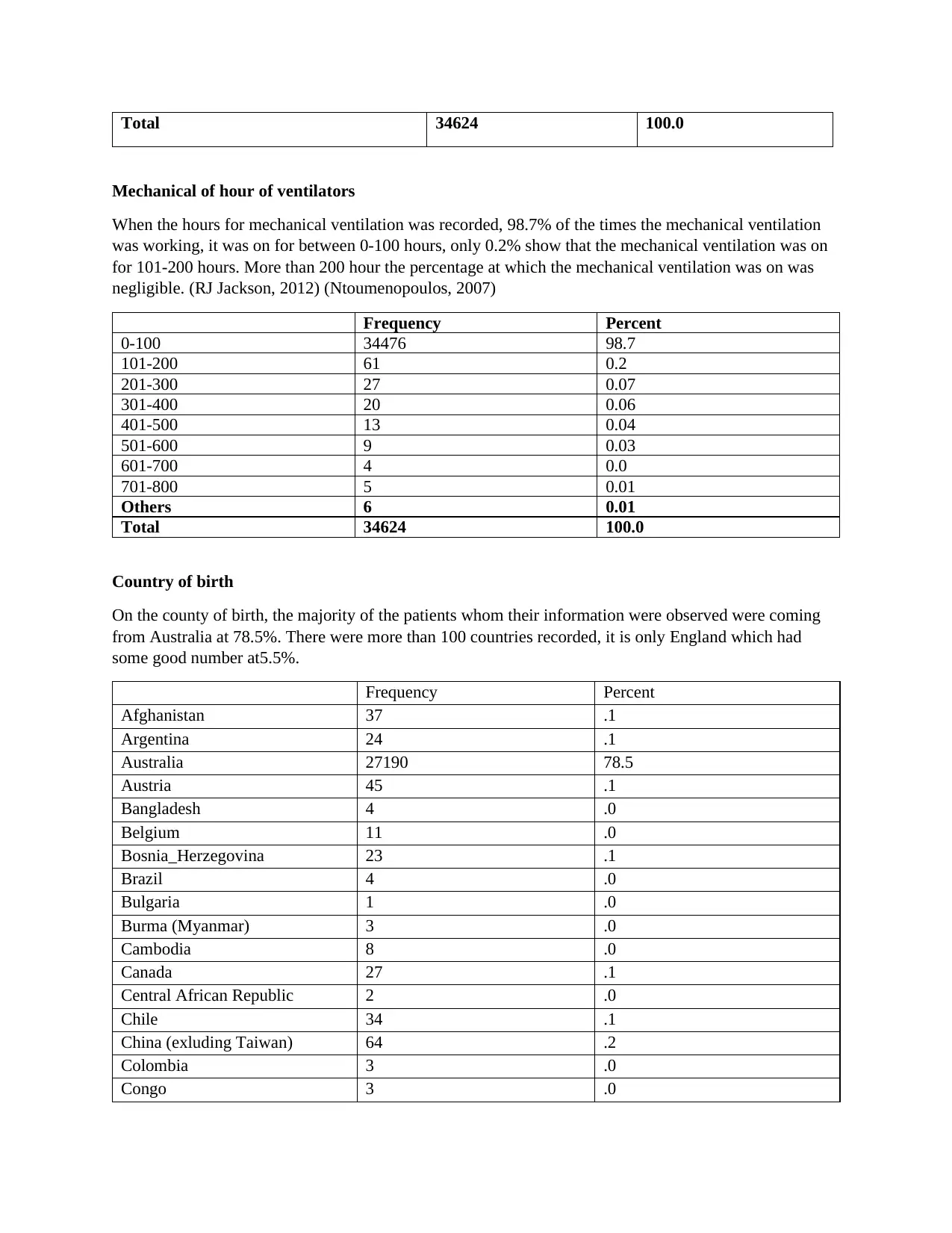
Total 34624 100.0
Mechanical of hour of ventilators
When the hours for mechanical ventilation was recorded, 98.7% of the times the mechanical ventilation
was working, it was on for between 0-100 hours, only 0.2% show that the mechanical ventilation was on
for 101-200 hours. More than 200 hour the percentage at which the mechanical ventilation was on was
negligible. (RJ Jackson, 2012) (Ntoumenopoulos, 2007)
Frequency Percent
0-100 34476 98.7
101-200 61 0.2
201-300 27 0.07
301-400 20 0.06
401-500 13 0.04
501-600 9 0.03
601-700 4 0.0
701-800 5 0.01
Others 6 0.01
Total 34624 100.0
Country of birth
On the county of birth, the majority of the patients whom their information were observed were coming
from Australia at 78.5%. There were more than 100 countries recorded, it is only England which had
some good number at5.5%.
Frequency Percent
Afghanistan 37 .1
Argentina 24 .1
Australia 27190 78.5
Austria 45 .1
Bangladesh 4 .0
Belgium 11 .0
Bosnia_Herzegovina 23 .1
Brazil 4 .0
Bulgaria 1 .0
Burma (Myanmar) 3 .0
Cambodia 8 .0
Canada 27 .1
Central African Republic 2 .0
Chile 34 .1
China (exluding Taiwan) 64 .2
Colombia 3 .0
Congo 3 .0
Mechanical of hour of ventilators
When the hours for mechanical ventilation was recorded, 98.7% of the times the mechanical ventilation
was working, it was on for between 0-100 hours, only 0.2% show that the mechanical ventilation was on
for 101-200 hours. More than 200 hour the percentage at which the mechanical ventilation was on was
negligible. (RJ Jackson, 2012) (Ntoumenopoulos, 2007)
Frequency Percent
0-100 34476 98.7
101-200 61 0.2
201-300 27 0.07
301-400 20 0.06
401-500 13 0.04
501-600 9 0.03
601-700 4 0.0
701-800 5 0.01
Others 6 0.01
Total 34624 100.0
Country of birth
On the county of birth, the majority of the patients whom their information were observed were coming
from Australia at 78.5%. There were more than 100 countries recorded, it is only England which had
some good number at5.5%.
Frequency Percent
Afghanistan 37 .1
Argentina 24 .1
Australia 27190 78.5
Austria 45 .1
Bangladesh 4 .0
Belgium 11 .0
Bosnia_Herzegovina 23 .1
Brazil 4 .0
Bulgaria 1 .0
Burma (Myanmar) 3 .0
Cambodia 8 .0
Canada 27 .1
Central African Republic 2 .0
Chile 34 .1
China (exluding Taiwan) 64 .2
Colombia 3 .0
Congo 3 .0
Paraphrase This Document
Need a fresh take? Get an instant paraphrase of this document with our AI Paraphraser
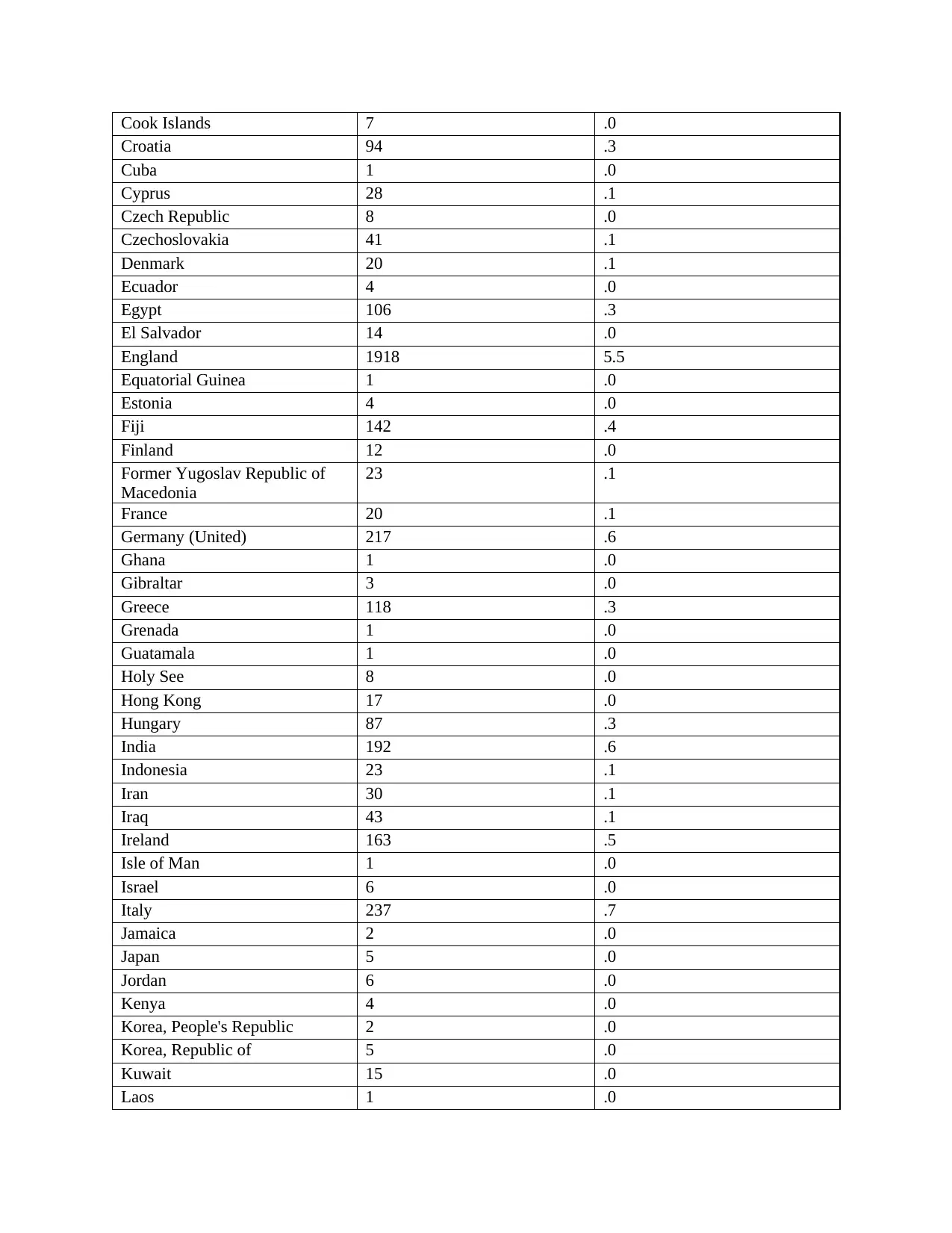
Cook Islands 7 .0
Croatia 94 .3
Cuba 1 .0
Cyprus 28 .1
Czech Republic 8 .0
Czechoslovakia 41 .1
Denmark 20 .1
Ecuador 4 .0
Egypt 106 .3
El Salvador 14 .0
England 1918 5.5
Equatorial Guinea 1 .0
Estonia 4 .0
Fiji 142 .4
Finland 12 .0
Former Yugoslav Republic of
Macedonia
23 .1
France 20 .1
Germany (United) 217 .6
Ghana 1 .0
Gibraltar 3 .0
Greece 118 .3
Grenada 1 .0
Guatamala 1 .0
Holy See 8 .0
Hong Kong 17 .0
Hungary 87 .3
India 192 .6
Indonesia 23 .1
Iran 30 .1
Iraq 43 .1
Ireland 163 .5
Isle of Man 1 .0
Israel 6 .0
Italy 237 .7
Jamaica 2 .0
Japan 5 .0
Jordan 6 .0
Kenya 4 .0
Korea, People's Republic 2 .0
Korea, Republic of 5 .0
Kuwait 15 .0
Laos 1 .0
Croatia 94 .3
Cuba 1 .0
Cyprus 28 .1
Czech Republic 8 .0
Czechoslovakia 41 .1
Denmark 20 .1
Ecuador 4 .0
Egypt 106 .3
El Salvador 14 .0
England 1918 5.5
Equatorial Guinea 1 .0
Estonia 4 .0
Fiji 142 .4
Finland 12 .0
Former Yugoslav Republic of
Macedonia
23 .1
France 20 .1
Germany (United) 217 .6
Ghana 1 .0
Gibraltar 3 .0
Greece 118 .3
Grenada 1 .0
Guatamala 1 .0
Holy See 8 .0
Hong Kong 17 .0
Hungary 87 .3
India 192 .6
Indonesia 23 .1
Iran 30 .1
Iraq 43 .1
Ireland 163 .5
Isle of Man 1 .0
Israel 6 .0
Italy 237 .7
Jamaica 2 .0
Japan 5 .0
Jordan 6 .0
Kenya 4 .0
Korea, People's Republic 2 .0
Korea, Republic of 5 .0
Kuwait 15 .0
Laos 1 .0
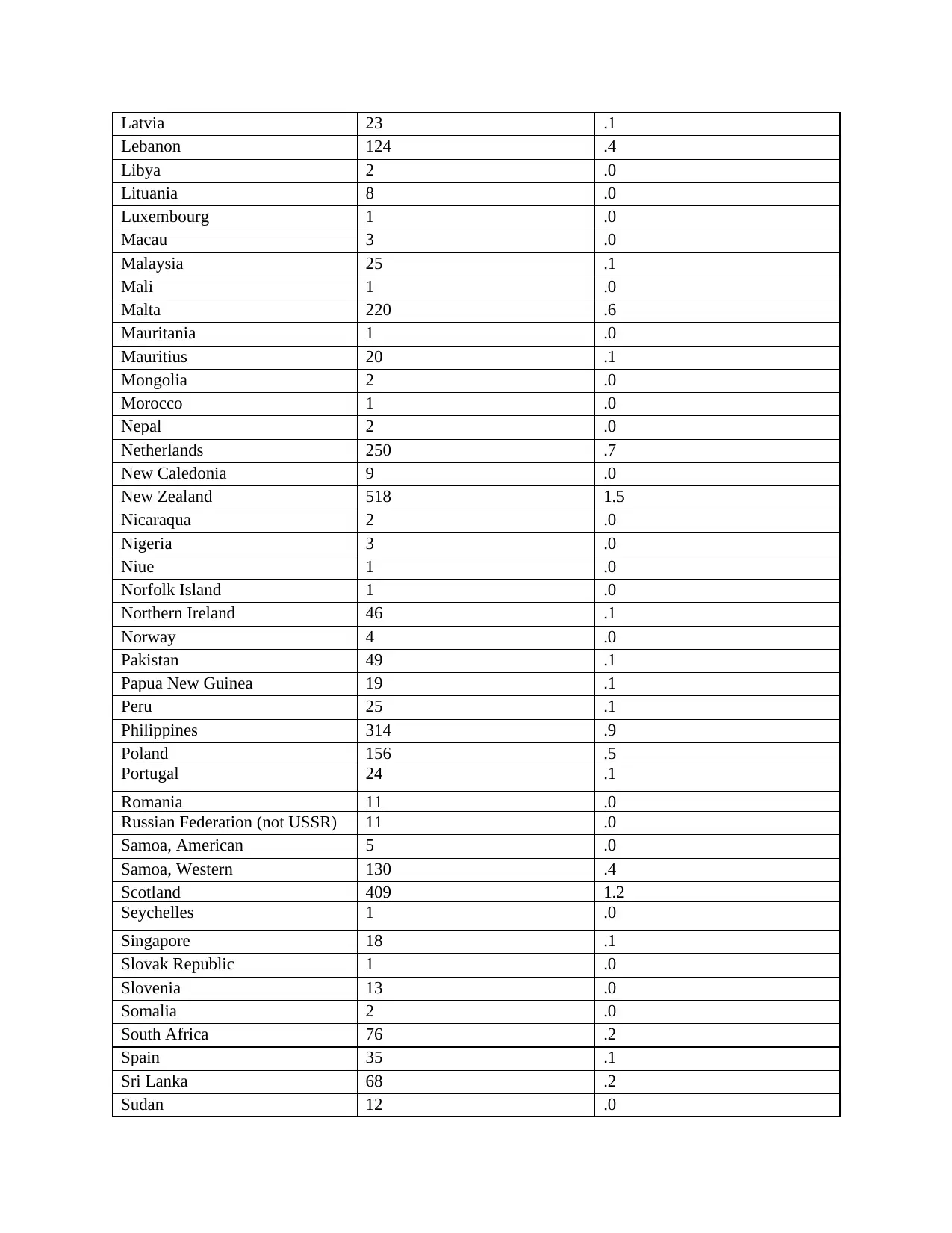
Latvia 23 .1
Lebanon 124 .4
Libya 2 .0
Lituania 8 .0
Luxembourg 1 .0
Macau 3 .0
Malaysia 25 .1
Mali 1 .0
Malta 220 .6
Mauritania 1 .0
Mauritius 20 .1
Mongolia 2 .0
Morocco 1 .0
Nepal 2 .0
Netherlands 250 .7
New Caledonia 9 .0
New Zealand 518 1.5
Nicaraqua 2 .0
Nigeria 3 .0
Niue 1 .0
Norfolk Island 1 .0
Northern Ireland 46 .1
Norway 4 .0
Pakistan 49 .1
Papua New Guinea 19 .1
Peru 25 .1
Philippines 314 .9
Poland 156 .5
Portugal 24 .1
Romania 11 .0
Russian Federation (not USSR) 11 .0
Samoa, American 5 .0
Samoa, Western 130 .4
Scotland 409 1.2
Seychelles 1 .0
Singapore 18 .1
Slovak Republic 1 .0
Slovenia 13 .0
Somalia 2 .0
South Africa 76 .2
Spain 35 .1
Sri Lanka 68 .2
Sudan 12 .0
Lebanon 124 .4
Libya 2 .0
Lituania 8 .0
Luxembourg 1 .0
Macau 3 .0
Malaysia 25 .1
Mali 1 .0
Malta 220 .6
Mauritania 1 .0
Mauritius 20 .1
Mongolia 2 .0
Morocco 1 .0
Nepal 2 .0
Netherlands 250 .7
New Caledonia 9 .0
New Zealand 518 1.5
Nicaraqua 2 .0
Nigeria 3 .0
Niue 1 .0
Norfolk Island 1 .0
Northern Ireland 46 .1
Norway 4 .0
Pakistan 49 .1
Papua New Guinea 19 .1
Peru 25 .1
Philippines 314 .9
Poland 156 .5
Portugal 24 .1
Romania 11 .0
Russian Federation (not USSR) 11 .0
Samoa, American 5 .0
Samoa, Western 130 .4
Scotland 409 1.2
Seychelles 1 .0
Singapore 18 .1
Slovak Republic 1 .0
Slovenia 13 .0
Somalia 2 .0
South Africa 76 .2
Spain 35 .1
Sri Lanka 68 .2
Sudan 12 .0
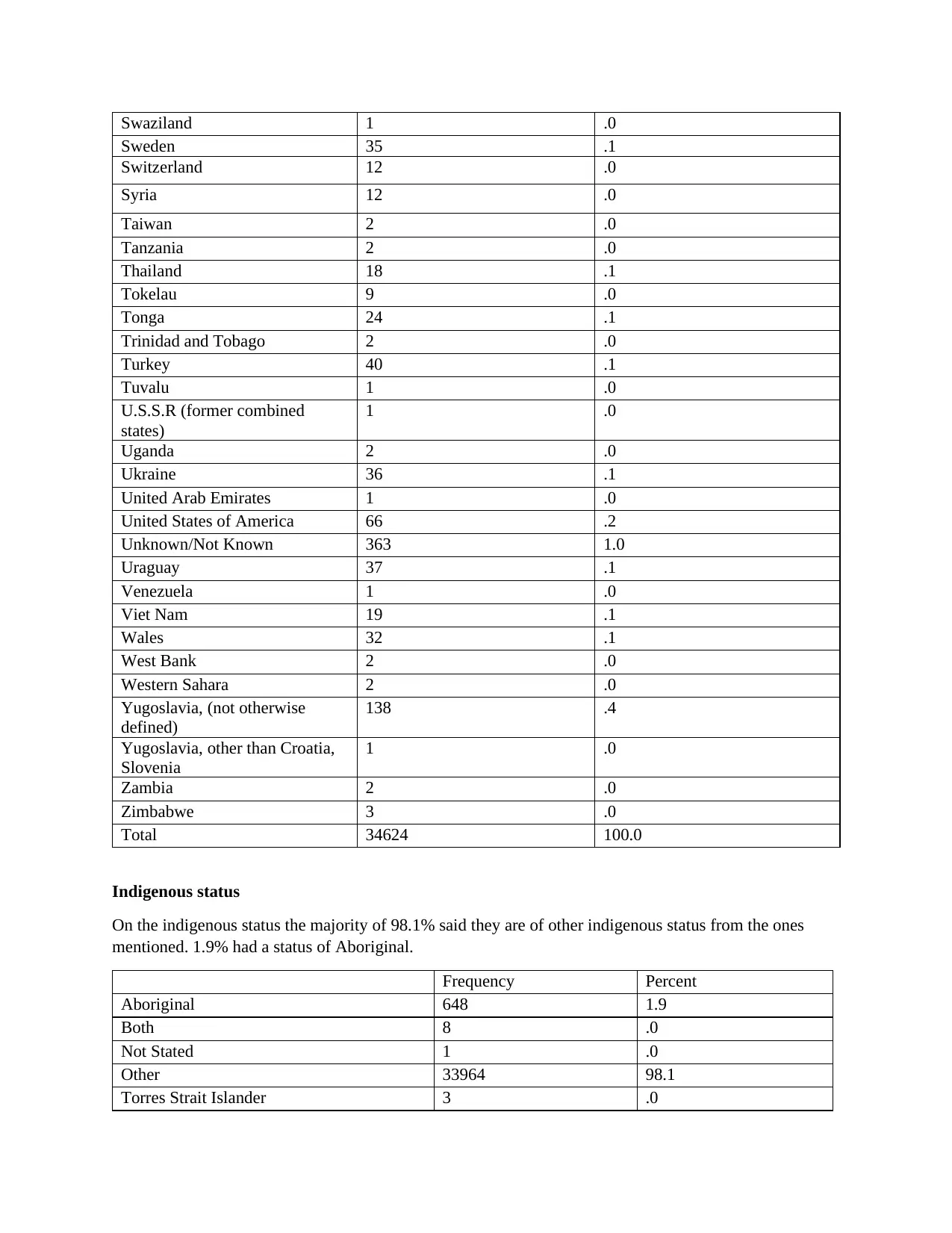
Swaziland 1 .0
Sweden 35 .1
Switzerland 12 .0
Syria 12 .0
Taiwan 2 .0
Tanzania 2 .0
Thailand 18 .1
Tokelau 9 .0
Tonga 24 .1
Trinidad and Tobago 2 .0
Turkey 40 .1
Tuvalu 1 .0
U.S.S.R (former combined
states)
1 .0
Uganda 2 .0
Ukraine 36 .1
United Arab Emirates 1 .0
United States of America 66 .2
Unknown/Not Known 363 1.0
Uraguay 37 .1
Venezuela 1 .0
Viet Nam 19 .1
Wales 32 .1
West Bank 2 .0
Western Sahara 2 .0
Yugoslavia, (not otherwise
defined)
138 .4
Yugoslavia, other than Croatia,
Slovenia
1 .0
Zambia 2 .0
Zimbabwe 3 .0
Total 34624 100.0
Indigenous status
On the indigenous status the majority of 98.1% said they are of other indigenous status from the ones
mentioned. 1.9% had a status of Aboriginal.
Frequency Percent
Aboriginal 648 1.9
Both 8 .0
Not Stated 1 .0
Other 33964 98.1
Torres Strait Islander 3 .0
Sweden 35 .1
Switzerland 12 .0
Syria 12 .0
Taiwan 2 .0
Tanzania 2 .0
Thailand 18 .1
Tokelau 9 .0
Tonga 24 .1
Trinidad and Tobago 2 .0
Turkey 40 .1
Tuvalu 1 .0
U.S.S.R (former combined
states)
1 .0
Uganda 2 .0
Ukraine 36 .1
United Arab Emirates 1 .0
United States of America 66 .2
Unknown/Not Known 363 1.0
Uraguay 37 .1
Venezuela 1 .0
Viet Nam 19 .1
Wales 32 .1
West Bank 2 .0
Western Sahara 2 .0
Yugoslavia, (not otherwise
defined)
138 .4
Yugoslavia, other than Croatia,
Slovenia
1 .0
Zambia 2 .0
Zimbabwe 3 .0
Total 34624 100.0
Indigenous status
On the indigenous status the majority of 98.1% said they are of other indigenous status from the ones
mentioned. 1.9% had a status of Aboriginal.
Frequency Percent
Aboriginal 648 1.9
Both 8 .0
Not Stated 1 .0
Other 33964 98.1
Torres Strait Islander 3 .0
Secure Best Marks with AI Grader
Need help grading? Try our AI Grader for instant feedback on your assignments.
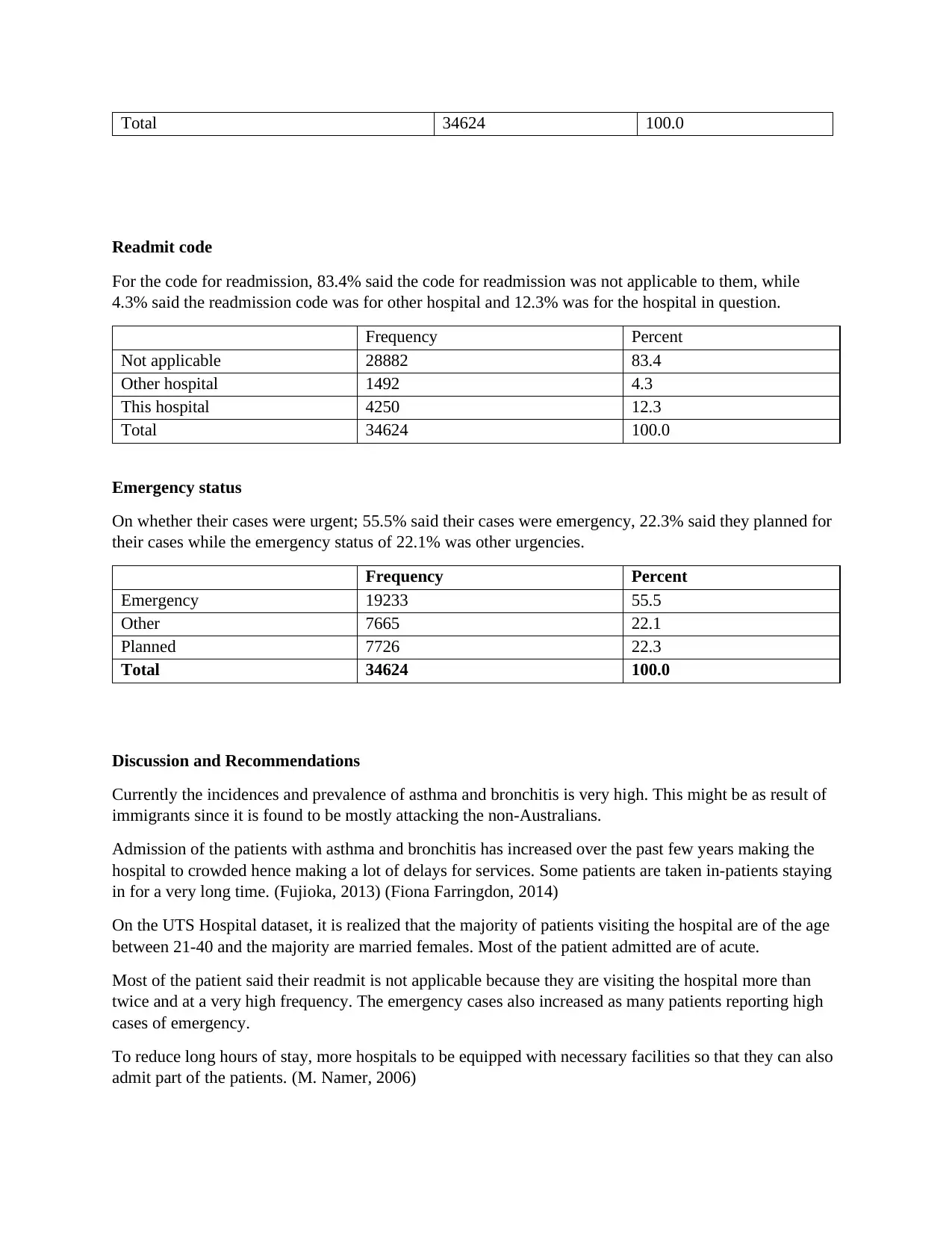
Total 34624 100.0
Readmit code
For the code for readmission, 83.4% said the code for readmission was not applicable to them, while
4.3% said the readmission code was for other hospital and 12.3% was for the hospital in question.
Frequency Percent
Not applicable 28882 83.4
Other hospital 1492 4.3
This hospital 4250 12.3
Total 34624 100.0
Emergency status
On whether their cases were urgent; 55.5% said their cases were emergency, 22.3% said they planned for
their cases while the emergency status of 22.1% was other urgencies.
Frequency Percent
Emergency 19233 55.5
Other 7665 22.1
Planned 7726 22.3
Total 34624 100.0
Discussion and Recommendations
Currently the incidences and prevalence of asthma and bronchitis is very high. This might be as result of
immigrants since it is found to be mostly attacking the non-Australians.
Admission of the patients with asthma and bronchitis has increased over the past few years making the
hospital to crowded hence making a lot of delays for services. Some patients are taken in-patients staying
in for a very long time. (Fujioka, 2013) (Fiona Farringdon, 2014)
On the UTS Hospital dataset, it is realized that the majority of patients visiting the hospital are of the age
between 21-40 and the majority are married females. Most of the patient admitted are of acute.
Most of the patient said their readmit is not applicable because they are visiting the hospital more than
twice and at a very high frequency. The emergency cases also increased as many patients reporting high
cases of emergency.
To reduce long hours of stay, more hospitals to be equipped with necessary facilities so that they can also
admit part of the patients. (M. Namer, 2006)
Readmit code
For the code for readmission, 83.4% said the code for readmission was not applicable to them, while
4.3% said the readmission code was for other hospital and 12.3% was for the hospital in question.
Frequency Percent
Not applicable 28882 83.4
Other hospital 1492 4.3
This hospital 4250 12.3
Total 34624 100.0
Emergency status
On whether their cases were urgent; 55.5% said their cases were emergency, 22.3% said they planned for
their cases while the emergency status of 22.1% was other urgencies.
Frequency Percent
Emergency 19233 55.5
Other 7665 22.1
Planned 7726 22.3
Total 34624 100.0
Discussion and Recommendations
Currently the incidences and prevalence of asthma and bronchitis is very high. This might be as result of
immigrants since it is found to be mostly attacking the non-Australians.
Admission of the patients with asthma and bronchitis has increased over the past few years making the
hospital to crowded hence making a lot of delays for services. Some patients are taken in-patients staying
in for a very long time. (Fujioka, 2013) (Fiona Farringdon, 2014)
On the UTS Hospital dataset, it is realized that the majority of patients visiting the hospital are of the age
between 21-40 and the majority are married females. Most of the patient admitted are of acute.
Most of the patient said their readmit is not applicable because they are visiting the hospital more than
twice and at a very high frequency. The emergency cases also increased as many patients reporting high
cases of emergency.
To reduce long hours of stay, more hospitals to be equipped with necessary facilities so that they can also
admit part of the patients. (M. Namer, 2006)
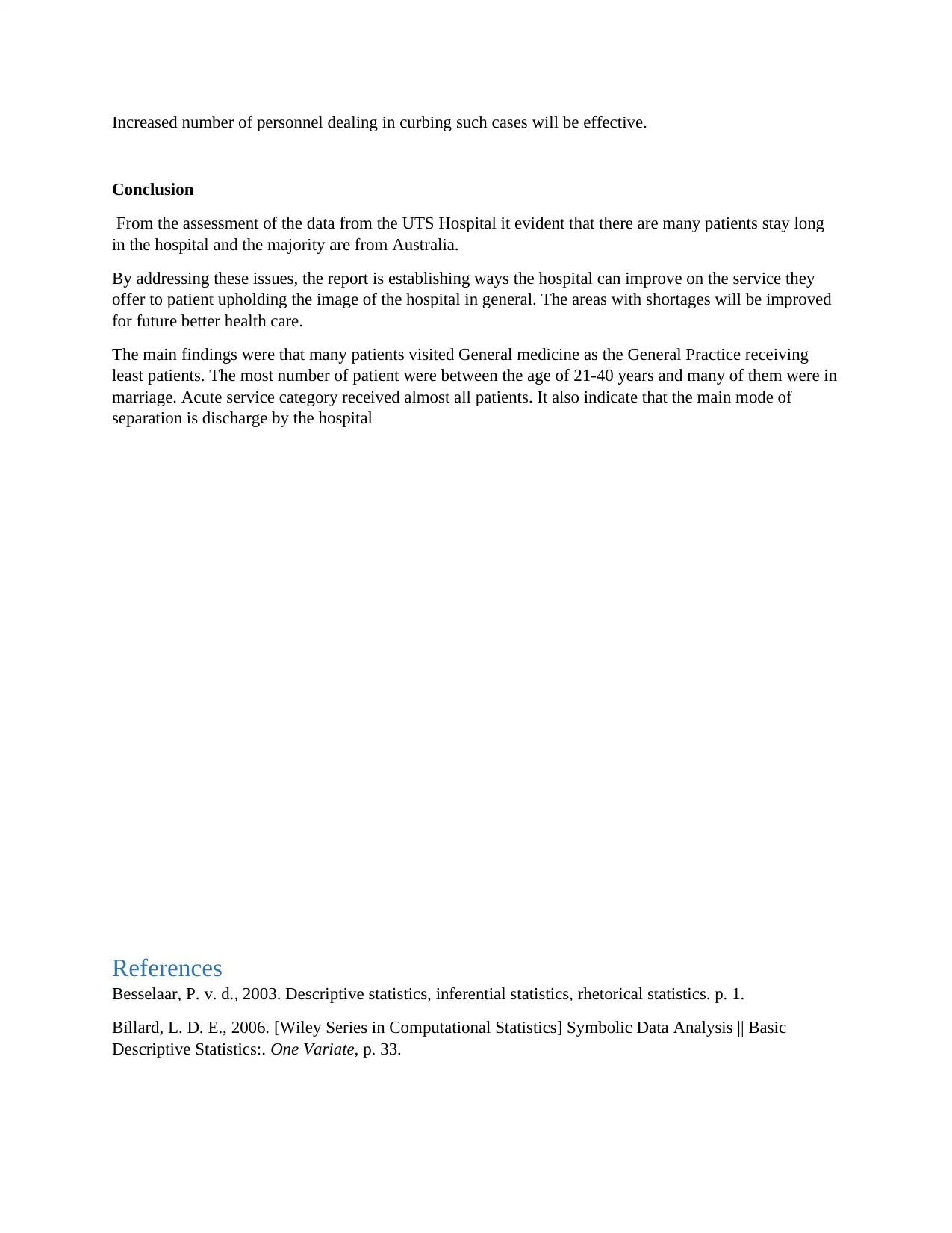
Increased number of personnel dealing in curbing such cases will be effective.
Conclusion
From the assessment of the data from the UTS Hospital it evident that there are many patients stay long
in the hospital and the majority are from Australia.
By addressing these issues, the report is establishing ways the hospital can improve on the service they
offer to patient upholding the image of the hospital in general. The areas with shortages will be improved
for future better health care.
The main findings were that many patients visited General medicine as the General Practice receiving
least patients. The most number of patient were between the age of 21-40 years and many of them were in
marriage. Acute service category received almost all patients. It also indicate that the main mode of
separation is discharge by the hospital
References
Besselaar, P. v. d., 2003. Descriptive statistics, inferential statistics, rhetorical statistics. p. 1.
Billard, L. D. E., 2006. [Wiley Series in Computational Statistics] Symbolic Data Analysis || Basic
Descriptive Statistics:. One Variate, p. 33.
Conclusion
From the assessment of the data from the UTS Hospital it evident that there are many patients stay long
in the hospital and the majority are from Australia.
By addressing these issues, the report is establishing ways the hospital can improve on the service they
offer to patient upholding the image of the hospital in general. The areas with shortages will be improved
for future better health care.
The main findings were that many patients visited General medicine as the General Practice receiving
least patients. The most number of patient were between the age of 21-40 years and many of them were in
marriage. Acute service category received almost all patients. It also indicate that the main mode of
separation is discharge by the hospital
References
Besselaar, P. v. d., 2003. Descriptive statistics, inferential statistics, rhetorical statistics. p. 1.
Billard, L. D. E., 2006. [Wiley Series in Computational Statistics] Symbolic Data Analysis || Basic
Descriptive Statistics:. One Variate, p. 33.
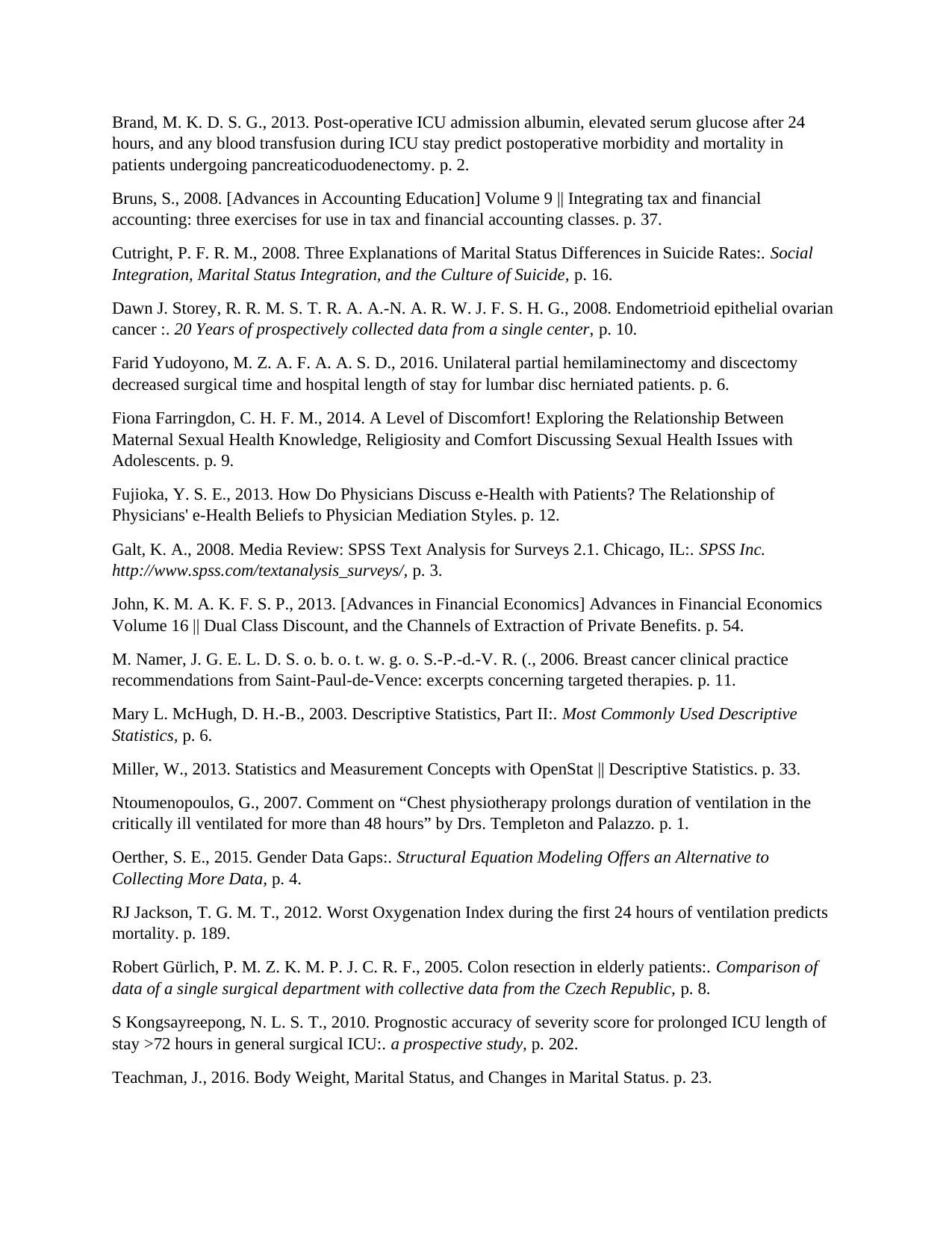
Brand, M. K. D. S. G., 2013. Post-operative ICU admission albumin, elevated serum glucose after 24
hours, and any blood transfusion during ICU stay predict postoperative morbidity and mortality in
patients undergoing pancreaticoduodenectomy. p. 2.
Bruns, S., 2008. [Advances in Accounting Education] Volume 9 || Integrating tax and financial
accounting: three exercises for use in tax and financial accounting classes. p. 37.
Cutright, P. F. R. M., 2008. Three Explanations of Marital Status Differences in Suicide Rates:. Social
Integration, Marital Status Integration, and the Culture of Suicide, p. 16.
Dawn J. Storey, R. R. M. S. T. R. A. A.-N. A. R. W. J. F. S. H. G., 2008. Endometrioid epithelial ovarian
cancer :. 20 Years of prospectively collected data from a single center, p. 10.
Farid Yudoyono, M. Z. A. F. A. A. S. D., 2016. Unilateral partial hemilaminectomy and discectomy
decreased surgical time and hospital length of stay for lumbar disc herniated patients. p. 6.
Fiona Farringdon, C. H. F. M., 2014. A Level of Discomfort! Exploring the Relationship Between
Maternal Sexual Health Knowledge, Religiosity and Comfort Discussing Sexual Health Issues with
Adolescents. p. 9.
Fujioka, Y. S. E., 2013. How Do Physicians Discuss e-Health with Patients? The Relationship of
Physicians' e-Health Beliefs to Physician Mediation Styles. p. 12.
Galt, K. A., 2008. Media Review: SPSS Text Analysis for Surveys 2.1. Chicago, IL:. SPSS Inc.
http://www.spss.com/textanalysis_surveys/, p. 3.
John, K. M. A. K. F. S. P., 2013. [Advances in Financial Economics] Advances in Financial Economics
Volume 16 || Dual Class Discount, and the Channels of Extraction of Private Benefits. p. 54.
M. Namer, J. G. E. L. D. S. o. b. o. t. w. g. o. S.-P.-d.-V. R. (., 2006. Breast cancer clinical practice
recommendations from Saint-Paul-de-Vence: excerpts concerning targeted therapies. p. 11.
Mary L. McHugh, D. H.-B., 2003. Descriptive Statistics, Part II:. Most Commonly Used Descriptive
Statistics, p. 6.
Miller, W., 2013. Statistics and Measurement Concepts with OpenStat || Descriptive Statistics. p. 33.
Ntoumenopoulos, G., 2007. Comment on “Chest physiotherapy prolongs duration of ventilation in the
critically ill ventilated for more than 48 hours” by Drs. Templeton and Palazzo. p. 1.
Oerther, S. E., 2015. Gender Data Gaps:. Structural Equation Modeling Offers an Alternative to
Collecting More Data, p. 4.
RJ Jackson, T. G. M. T., 2012. Worst Oxygenation Index during the first 24 hours of ventilation predicts
mortality. p. 189.
Robert Gürlich, P. M. Z. K. M. P. J. C. R. F., 2005. Colon resection in elderly patients:. Comparison of
data of a single surgical department with collective data from the Czech Republic, p. 8.
S Kongsayreepong, N. L. S. T., 2010. Prognostic accuracy of severity score for prolonged ICU length of
stay >72 hours in general surgical ICU:. a prospective study, p. 202.
Teachman, J., 2016. Body Weight, Marital Status, and Changes in Marital Status. p. 23.
hours, and any blood transfusion during ICU stay predict postoperative morbidity and mortality in
patients undergoing pancreaticoduodenectomy. p. 2.
Bruns, S., 2008. [Advances in Accounting Education] Volume 9 || Integrating tax and financial
accounting: three exercises for use in tax and financial accounting classes. p. 37.
Cutright, P. F. R. M., 2008. Three Explanations of Marital Status Differences in Suicide Rates:. Social
Integration, Marital Status Integration, and the Culture of Suicide, p. 16.
Dawn J. Storey, R. R. M. S. T. R. A. A.-N. A. R. W. J. F. S. H. G., 2008. Endometrioid epithelial ovarian
cancer :. 20 Years of prospectively collected data from a single center, p. 10.
Farid Yudoyono, M. Z. A. F. A. A. S. D., 2016. Unilateral partial hemilaminectomy and discectomy
decreased surgical time and hospital length of stay for lumbar disc herniated patients. p. 6.
Fiona Farringdon, C. H. F. M., 2014. A Level of Discomfort! Exploring the Relationship Between
Maternal Sexual Health Knowledge, Religiosity and Comfort Discussing Sexual Health Issues with
Adolescents. p. 9.
Fujioka, Y. S. E., 2013. How Do Physicians Discuss e-Health with Patients? The Relationship of
Physicians' e-Health Beliefs to Physician Mediation Styles. p. 12.
Galt, K. A., 2008. Media Review: SPSS Text Analysis for Surveys 2.1. Chicago, IL:. SPSS Inc.
http://www.spss.com/textanalysis_surveys/, p. 3.
John, K. M. A. K. F. S. P., 2013. [Advances in Financial Economics] Advances in Financial Economics
Volume 16 || Dual Class Discount, and the Channels of Extraction of Private Benefits. p. 54.
M. Namer, J. G. E. L. D. S. o. b. o. t. w. g. o. S.-P.-d.-V. R. (., 2006. Breast cancer clinical practice
recommendations from Saint-Paul-de-Vence: excerpts concerning targeted therapies. p. 11.
Mary L. McHugh, D. H.-B., 2003. Descriptive Statistics, Part II:. Most Commonly Used Descriptive
Statistics, p. 6.
Miller, W., 2013. Statistics and Measurement Concepts with OpenStat || Descriptive Statistics. p. 33.
Ntoumenopoulos, G., 2007. Comment on “Chest physiotherapy prolongs duration of ventilation in the
critically ill ventilated for more than 48 hours” by Drs. Templeton and Palazzo. p. 1.
Oerther, S. E., 2015. Gender Data Gaps:. Structural Equation Modeling Offers an Alternative to
Collecting More Data, p. 4.
RJ Jackson, T. G. M. T., 2012. Worst Oxygenation Index during the first 24 hours of ventilation predicts
mortality. p. 189.
Robert Gürlich, P. M. Z. K. M. P. J. C. R. F., 2005. Colon resection in elderly patients:. Comparison of
data of a single surgical department with collective data from the Czech Republic, p. 8.
S Kongsayreepong, N. L. S. T., 2010. Prognostic accuracy of severity score for prolonged ICU length of
stay >72 hours in general surgical ICU:. a prospective study, p. 202.
Teachman, J., 2016. Body Weight, Marital Status, and Changes in Marital Status. p. 23.
Paraphrase This Document
Need a fresh take? Get an instant paraphrase of this document with our AI Paraphraser

1 out of 14
Related Documents
Your All-in-One AI-Powered Toolkit for Academic Success.
+13062052269
info@desklib.com
Available 24*7 on WhatsApp / Email
![[object Object]](/_next/static/media/star-bottom.7253800d.svg)
Unlock your academic potential
© 2024 | Zucol Services PVT LTD | All rights reserved.





